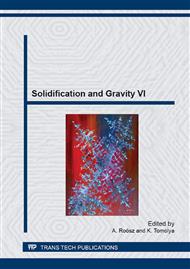[1]
M. Abtew, G. Selvaduray, Lead-free Solders in Microelectronics, Materials Science and Engineering 27 (2000) 95-141.
DOI: 10.1016/s0927-796x(00)00010-3
Google Scholar
[2]
B. -Z. Lee, D. N. Lee, Spontaneous Growth Mechanism of Tin Whiskers, Acta Materialia 46 (1998) 3701-3714.
DOI: 10.1016/s1359-6454(98)00045-7
Google Scholar
[3]
K.G. Compton, A. Mendizza, and S.M. Arnold, Filamentary Growths on Metal Surfaces Whiskers, Corrosion 7 (1951) 327-334.
DOI: 10.5006/0010-9312-7.10.327
Google Scholar
[4]
D.J. Barber, Growth of Aluminium Whiskers by Vapour Condensation, Nature. 194 (1962) 272-273.
DOI: 10.1038/194272c0
Google Scholar
[5]
A. Skwarek, K. Witek, J. Ratajczak, Risk of whiskers formation on the surface of commercially available tin-rich alloys under thermal shocks, Microelectronics Reliability 49 (2009) 569-572.
DOI: 10.1016/j.microrel.2009.02.026
Google Scholar
[6]
T. Fang, M. Osterman, M. Pecht, Statistical analysis of tin whisker growth, Microelectronics Reliability. 46 (2006) 846-849.
DOI: 10.1016/j.microrel.2005.06.002
Google Scholar
[7]
B. Illés, B. Horváth, G. Harsányi, Effect of strongly oxidizing environment on whisker growth form tin coating, Surface & Coatings Technology 205 (2010) 2262-2266.
DOI: 10.1016/j.surfcoat.2010.09.012
Google Scholar
[8]
A. Skwarek, J. Ratajczak, A. Czerwinski, K. Witek, J. Kulawik, Effect of Cu addition on whisker formation in tin-rich solder alloys under thermal shock stress, Applied Surface Science 255 (2009) 7100-7103.
DOI: 10.1016/j.apsusc.2009.03.002
Google Scholar
[9]
T.H. Chuang, H.J. Lin, C.C. Chi, Rapid growth of tin whiskers on the surface of Sn–6. 6Lu alloy, Scripta Materialia 56 (2007) 45-48.
DOI: 10.1016/j.scriptamat.2006.08.061
Google Scholar
[10]
T.H. Chuang, Rapid whisker growth on the surface of Sn-3Ag-0. 5Cu-1. 0Ce solder joints, Scripta Materialia. 55 (2006) 983-986.
DOI: 10.1016/j.scriptamat.2006.08.024
Google Scholar
[11]
E. Chason, N. Jadhav, F. Pei, E. Buchovecky, A. Bower, Growth of whiskers from Sn surfaces: Driving forces and growth mechanisms, Progr. Surface Science 88 (2013) 103-131.
DOI: 10.1016/j.progsurf.2013.02.002
Google Scholar
[12]
N. Jiang, M. Yang, J. Novak, P. Igor, M. Osterman, Sn whiskers removed by energy photo flashing, Applied Surface Science 258 (2012) 9599-9603.
DOI: 10.1016/j.apsusc.2012.05.155
Google Scholar
[13]
S.C. Britton, Spontaneous Growth of Whiskers on Tin Coatings: 20 Years of Observation, Trans. of the Institute of Metal Finishing 52 (1974) 95-102.
DOI: 10.1080/00202967.1974.11870313
Google Scholar
[14]
A. Selcuker, M. Johnson, Microstructural Characterization of Electrodeposited Tin Layer in Relation to Whisker Growth, Capacitor and Resistor Technology Symposium Proc., CARTS (1990) 19-22.
Google Scholar
[15]
C. -K. Lin, T. -H. Lin, Effects of continuously applied stress on tin whisker growth, Microelectronics Reliability 48 (2008) 1738-1740.
DOI: 10.1016/j.microrel.2008.04.013
Google Scholar
[16]
Y. Fukuda, M. Osterman, M. Pecht, The impact of electrical current, mechanical bending, and thermal annealing on tin whisker growth, Microelectronics Reliabilit. 47 (2007) 88-92.
DOI: 10.1016/j.microrel.2006.04.011
Google Scholar
[17]
S. -K. Lin,Y. Yorikado, J. Jiang, K. -S. Kim, K. Suganuma, S. -W. Chen, M. Tsujimoto, I. Yanada, Microstructure Development of Mechanical-Deformation-Induced Sn Whiskers, Journal of Electronic Materials 36 (2007) 1732-1734.
DOI: 10.1007/s11664-007-0284-4
Google Scholar
[18]
T. -H. Chuang, Temperature Effects on the Whiskers in Rare-Earth Doped Sn-3Ag-0. 5Cu-0. 5Ce Solder Joints, Metallurgical and Materials Transactions A, 38A (2007) 1048-1055.
DOI: 10.1007/s11661-007-9126-5
Google Scholar


